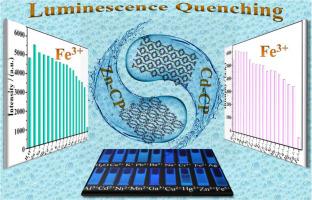Amide-functionalized coordination polymers for fluorescence detection of Fe3+ in aqueous solution
IF 4.7
2区 化学
Q2 CHEMISTRY, PHYSICAL
引用次数: 0
Abstract
Heavy metal pollution, particularly from Fe3+, poses significant environmental and health risks, necessitating sensitive and selective detection methods. This study presents two amide-functionalized coordination polymers (CPs), Zn-CP and Cd-CP, designed for efficient Fe3+ sensing in aqueous media. Both CPs exhibit remarkable fluorescence quenching selectivity toward Fe3+ due to rich amide functional sites for enhancing sensing capability, achieving low detection limits (LODs) of 3.92/3.35 μM in H2O and 5.14/4.84 μM in HEPES buffer, surpassing the World Health Organization (WHO) and United States Environmental Protection Agency (USEPA) drinking water standard (5.36 μM). The sensors demonstrate excellent selectivity, anti-interference capability, recyclability, and practical applicability through portable test strips for rapid visual detection. Multiple experiments co‒reveal that fluorescence quenching mechanism arises from competitive energy absorption induced by weak interactions between Fe3+ and the N/O-active sites of the amide-decorated frameworks. This work highlights the potential of ligand-engineered CPs for environmental monitoring, offering a robust platform for heavy metal detection with high sensitivity and practical applicability.

用于荧光检测水溶液中Fe3+的酰胺功能化配位聚合物
重金属污染,特别是来自Fe3+的污染,造成重大的环境和健康风险,需要敏感和选择性的检测方法。本研究提出了两种酰胺功能化配位聚合物(CPs), Zn-CP和Cd-CP,设计用于水介质中Fe3+的高效传感。由于具有丰富的酰胺功能位点,两种CPs对Fe3+具有显著的荧光猝灭选择性,在H2O和HEPES缓冲液中分别达到3.92/3.35 μM和5.14/4.84 μM的低检出限(lod),超过了世界卫生组织(WHO)和美国环保局(USEPA)饮用水标准(5.36 μM)。该传感器具有优异的选择性、抗干扰能力、可回收性和实用性,可通过便携式试纸进行快速视觉检测。多个实验共同揭示了荧光猝灭机制是由Fe3+与酰胺修饰框架的N/ o活性位点弱相互作用诱导的竞争性能量吸收引起的。这项工作突出了配体工程CPs在环境监测中的潜力,为具有高灵敏度和实用性的重金属检测提供了一个强大的平台。
本文章由计算机程序翻译,如有差异,请以英文原文为准。
求助全文
约1分钟内获得全文
求助全文
来源期刊

Journal of Molecular Structure
化学-物理化学
CiteScore
7.10
自引率
15.80%
发文量
2384
审稿时长
45 days
期刊介绍:
The Journal of Molecular Structure is dedicated to the publication of full-length articles and review papers, providing important new structural information on all types of chemical species including:
• Stable and unstable molecules in all types of environments (vapour, molecular beam, liquid, solution, liquid crystal, solid state, matrix-isolated, surface-absorbed etc.)
• Chemical intermediates
• Molecules in excited states
• Biological molecules
• Polymers.
The methods used may include any combination of spectroscopic and non-spectroscopic techniques, for example:
• Infrared spectroscopy (mid, far, near)
• Raman spectroscopy and non-linear Raman methods (CARS, etc.)
• Electronic absorption spectroscopy
• Optical rotatory dispersion and circular dichroism
• Fluorescence and phosphorescence techniques
• Electron spectroscopies (PES, XPS), EXAFS, etc.
• Microwave spectroscopy
• Electron diffraction
• NMR and ESR spectroscopies
• Mössbauer spectroscopy
• X-ray crystallography
• Charge Density Analyses
• Computational Studies (supplementing experimental methods)
We encourage publications combining theoretical and experimental approaches. The structural insights gained by the studies should be correlated with the properties, activity and/ or reactivity of the molecule under investigation and the relevance of this molecule and its implications should be discussed.
 求助内容:
求助内容: 应助结果提醒方式:
应助结果提醒方式:


